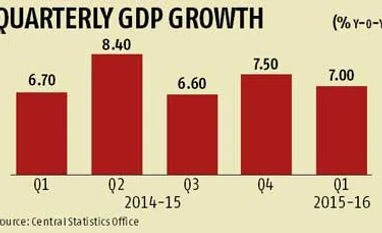The projected growth would be way below the 8.4 per cent witnessed in the second quarter of FY15. In fact, high GDP growth a year ago would also make economic expansion in the second quarter of this financial year look smaller, due to what is called 'base effect' in technical jargon.
The GDP data for the second quarter will be out on Monday. The first quarter number might also see a revision.
While most economists forecast the growth to be 7.3 per cent, Care Ratings Barclays and India Ratings put it bit higher. While Care Ratings expected the growth to be 7.4 per cent, Barclays projected it to be 7.5 per cent and India Ratings forecast it at 7.6 per cent. India Ratings (Ind-Ra) pegged the growth higher than other economists, as it believes the economy expanded that much in volume terms (GDP growth is taken without inflation).
Madan Sabnavis, chief economist at CARE Ratings, said the economy might have grown 7.4 per cent in the second quarter owing to high government expenditure and increase in manufacturing. After two years of squeeze, the government expenditure rose 6.9 per cent to Rs 4.79 lakh crore in the second quarter of FY16 against the corresponding period a year ago.
Expenditure had risen 4.2 per cent at Rs 4.3 lakh crore in the first quarter of FY16 compared to the corresponding quarter of the previous year.
D K Joshi of CRISIL pegged the GDP expansion at 7.3 per cent on the likely growth of industry and services. Industry, as represented by the IIP, rose 4.6 per cent in the second quarter against 3.2 per cent in the first quarter of FY16.
The broad gauge of the services sector is available from Nikkei Purchasing Managers' Index (PMI), though its methodology is not comparable to that of GDP data. PMI stood at 51.3 points on an average during July-September against 49.9 in April-June of 2015-16. It should be noted that a PMI below 50 points is contraction and one above that reading connotes expansion.
Aditi Nayar, senior economist with ICRA, also projected the economy to grow 7.3 per cent in the second quarter. She said IIP expanded at a faster pace in the second quarter than the previous one and each broad segment within the index rose at a higher rate. Manufacturing growth is already given above. Besides, mining output rose 2.7 per cent in the second quarter of 2015-16 against 0.4 per cent in the first quarter. Similarly, electricity rose 6.8 per cent against only 2.3 per cent in the same period.
Arun Singh of Dun & Bradstreet also pegged the growth at 7.3 per cent for the quarter under review, but cautioned it might drop to 6.9 as qualitatively, the three months do not look quite different from the first quarter.
Most economists believed it would take time for private investments to revive, the signs of which would be available from the second half. Moody's Analysts, too, expected the GDP to have expanded at 7.3 per cent in the second quarter. "Though the headline growth appears high, India is still operating under a negative output gap. Consumption will likely be a key driver to output in the September quarter," it said in a note.
When asked why Ind-Ra sees economic growth at a higher 7.6 per cent in the second quarter than what most economists believed, chief economist Devendra Pant attributed it to volume growth in the economy. For instance, he said, consumption of petroleum rose 8.5 per cent in the first half but because of price collapse of 20 per cent, there was contraction in value terms of 11 per cent. The government had earlier projected the economy to grow 8.1-8.5 per cent in 2015-16 against 7.3 per cent the previous year. However, surprised by a seven per cent growth in the first half, ministry officials said the growth would be 7.5-8 per cent. There is no official revision, though. The new projection would be disclosed by the ministry after the second quarter GDP numbers are released.
)